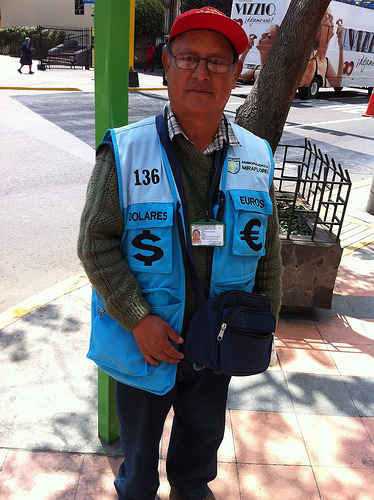Today, the foreign exchange market, or ‘currency market’ – you may also hear it commonly referred to as the ‘FX market’ or ‘forex market’ is the largest financial market in the world, trading more than $4trn around the world: every day. A third of this is traded in London.
Many of us tend to think of currency exchange only when preparing for a foreign holiday but the market is significantly larger than that: in the modern world, more people than ever before are sending money to and from countries overseas, and for a variety of different reasons – businesses importing or exporting goods or services abroad; private individuals with overseas property interests; or an expat living, working or studying away from home. At some stage it’s likely you’ll need help moving your money internationally.


Money man everywhere on the street by comicpie, on Flickr. This work is licensed under a Creative Commons Attribution 4.0 International License.
Trying to understand the currency markets may seem a daunting prospect but it isn’t that tricky. By understanding the exchange rates, you could save money when making an international currency transfer. This free information guide, prepared by World First Foreign Exchange, is a useful introduction to the market.
The foreign exchange market never sleeps – it’s open 24 hours a day between 20.15 GMT on a Sunday and 22.00 GMT on a Friday; during this time, thousands of factors affect each individual currency, ranging from American retail sales, to British political elections and natural disasters.
The markets are always evolving and prices change literally by the second. Exchange rates, too, can fluctuate over the course of a few days and make a difference to the amount of money you end up with. The exchange rate is determined by the value of one country’s currency against another. So, when you see a GBPEUR rate – which is the UK pound versus the Euro – of 1.15, that means every pound is worth €1.15. A higher rate means more Euro for your pounds, and therefore more for your money, which always makes for a pleasant bonus when travelling.
These rates change, and sometimes do so quite dramatically. For example, at the start of February 2013 the GBPEUR rate was €1.15 but fast forward 12 months to the beginning of February 2014 this year and the rate had changed to 1.22. What does this actually mean, in terms of money in your pocket? Well, in February 2013, if you had exchanged £1,000 into Euros, you’d have got €1,150. If you had changed the same amount in February 2014, you would have received over €1,220.
That’s an example of how a favourable exchange rate can make such a difference. Consider the same transaction, on a much larger scale – at a business level, say – and you can get a clearer idea of the importance of currency exchange, and understanding how it works.
